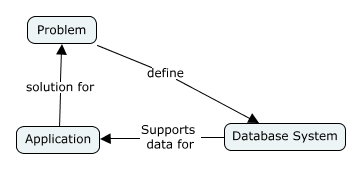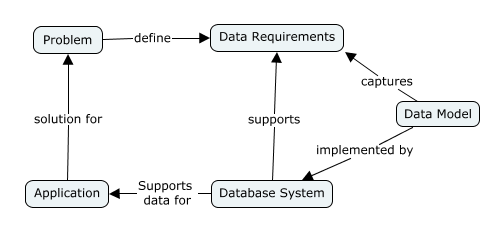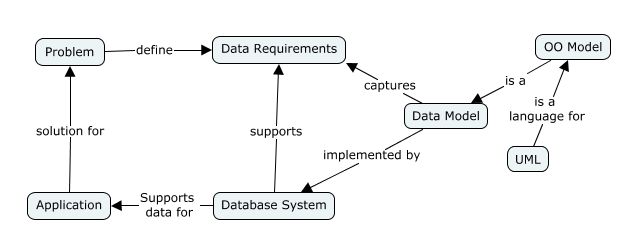The UML Model in Concept Map: A first few step as an example
by K. Yue
Example
The goal of this example is to eventually construct a concept map (CM) for the context of UML class diagram. The focus question is "what are UML class diagrams?" This example shows the first few steps of iterative refinement.
We start with a very simple high level CM for "database system."

Notes:
- There are only three concepts.
- Highlight that DB systems are for finding solutions to problems.
- Relevant Critical Thinking's Element of Thought (EoT): purpose, problem, assumption, solution, concept.
We refine and expand our CM model iteratively.

Notes:
- Promote "requirement" from a link (relationship) to a concept.
- Concepts are more flexible. It can have links. A link cannot has a link.
- Concepts and relationships become more specific in interactive refinement: E.g. "requirements" becomes "data requirements."
- Relevant CT EoT: problem, assumption, concept, information.

Notes:
- The key concept of data model is added.
- It is now obvious that there is a need to promote "data requirements" to a concept in the previous step for it to have a link with the concept "data model."
- Relevant CT EoT: concept, implication and consequence, inference, solution.

Notes:
- Once the context is clear, the central concept of "UML" is introduced as a language for the "OO Model", which is a "data model" that "captures" "data requirements."
- Relevant CT EoT: Point of view, concept.

Notes:
- Class diagram is introduced as a kind of diagrams in UML, which is eventually implemented in database systems in our context.
- Relevant CT EoT: concept, solution.

- Details of the UML class diagram can then be added.
- In the top level, a class diagram contains classes and associations between them.
- Relevant CT EoT: concept, inference.
- By adding them, future focal points are open up for the next iterative refinement steps. Examples:
- What is a class?
- How should we use classes to capture data requirement?
- What is an association?
- How should we use associations to model data requirement?
- How do we form associations between classes?
- Other components and details, such as attributes and methods can be added iteratively.
Note also:
- CT's intellectual standards are applied for the iteration of the concept maps, especially:
- Clarity
- Precision
- Breadth
- Depth
- Relevance
- Logic






